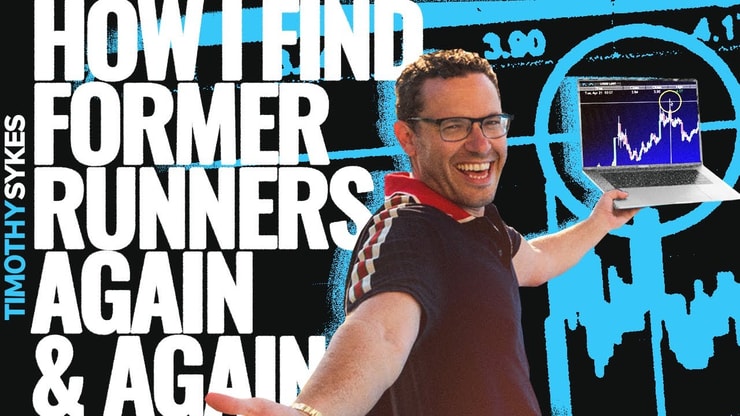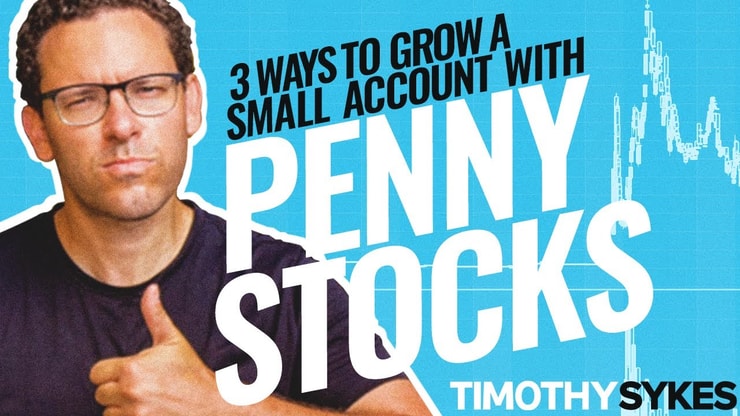Recently a Challenge student sent in an email listing all the trading rules they’d learned from me since joining the Challenge.
Here’s what they wrote:
“Been listening to Tim’s webinars and wrote down his rules. Here’s the list that I captured. Hope it can be helpful to others, too!”
So, now I’m sharing this list with you.
I just gotta say, it makes me so happy and proud as a teacher when students get it. This is why I give weekly live trading webinars for my Challenge students, make video lessons, and work like a mad man…
So I can give my students the rules and tools for the trading battlefield.
This student’s getting it, and I agree with these rules 100%. Let’s do this!
Table of Contents
- 1 22 Trading Rules From One of My Challenge Students
- 1.1 #1) Cut Losses Quickly
- 1.2 #2) Focus on Volatile Stocks
- 1.3 #3) Use StocksToTrade
- 1.4 #4) Buy Earnings Winners
- 1.5 #5) Look For Former Runners
- 1.6 #6) Resist FOMO (Fear of Missing Out)
- 1.7 #7) Learn The Patterns
- 1.8 #8) Small Accounts Are OK
- 1.9 #9) Use the Right Broker
- 1.10 #10) Focus on Buying Stocks That Can Spike Big
- 1.11 #11) Don’t Use Leverage
- 1.12 #12) Don’t Expect Success Right Away
- 1.13 #13) Stay Disciplined
- 1.14 #14) Use the Trader Checklist Guide
- 1.15 #15) Understand Opportunity Costs
- 1.16 #16) Think About Your Future
- 1.17 #17) Don’t Burnout
- 1.18 #18) Get Help From the Right Place
- 1.19 #19) Exact Formulas Don’t Exist in the Stock Market
- 1.20 #20) Take the Meat of the Move
- 1.21 #21) Perfection Is Impossible
- 1.22 #22) Try to Get Better Every Day, Day by Day … Forever
- 2 Trading Challenge
- 3 The Bottom Line
22 Trading Rules From One of My Challenge Students
#1) Cut Losses Quickly
This is my #1 of all my trading rules. It’s so important and yet too many students don’t do it.
Penny stocks are volatile. That means they can have big price swings. You have to be ready to cut losses quickly so that small mistakes don’t turn into major disasters.
Accept that losses are part of trading. I only win approximately 77% of the time. Cut losses quickly and keep your losses smaller than your gains. Then your small gains can add up over time.
#2) Focus on Volatile Stocks
This trading rule is a must. You want to be watching and trading stocks that have the potential to go supernova.
These stocks are usually big percent gainers, with a low float, a catalyst, and higher than average volume.
But remember rule #1 — because volatile stocks can have big swings to the upside and the downside.
New to penny stocks? Start with my free online guide here.
More Breaking News
- NU Stock: What’s Driving the Price Surge?
- Delta Air Lines: Is a Rebound on the Horizon?
- Top AI Penny Stocks to Watch in July 2025
#3) Use StocksToTrade
I’m glad this student gets it. Use StocksToTrade every day to search for the biggest percent gainers. It’s one of the best tools out there for finding and trading penny stocks.
I proudly helped design and develop StocksToTrade and I’m an investor in it. That’s why it has all the top tools for penny stocks. It has built-in, and customizable watchlists and scanners, a live Twitter feed. STT also has broker integration so you can trade right from the platform.
It puts everything you need in one place. And if you’re not trading with a live account, you can practice your setups and strategies with its paper trading feature.
Get a 14-day trial for only $7 now! Get the trail with the Breaking News Chat for only $17. The Breaking News Chat is responsible for a huge portion of my 2020 profits.* It’s an amazing tool — try it for yourself!
(*Please note: My results are far from typical. Individual results will vary. Most traders lose money. I have the benefit of years of hard work, dedication, and experience. Trading is inherently risky. Do your due diligence and never risk more than you can afford to lose.)
#4) Buy Earnings Winners
When it comes to trading rules, this one isn’t as straightforward. The market has ebb and flow — it’s like a moving target…
Sometimes patterns and catalysts work, and other times they don’t.
Lately, I haven’t seen earnings moving stocks as much as they used to. But it’s still an important trading rule to know. The markets change quickly! Earnings winners could come into play again…
None of this is an exact science — accept it.
I cover earnings winners, contract winners, and other stock catalysts in my “How to Make Millions” DVD. It’s my most comprehensive trading guide with hours and hours of lessons. All proceeds from the sale go to charity. It’s a win-win!
#5) Look For Former Runners
This is a very important trading rule to know. Once a stock has had a massive run, it’s easier for it to go supernova again. Traders remember former runners.
Short sellers remember them too. They know they have the potential to spike.
It’s important to always look back at multiple time frames on the chart to see what a stock did last time it had news or massive volume.
#6) Resist FOMO (Fear of Missing Out)
I agree with this one 100%. Trading isn’t you against another trader or the market, it’s you vs. you.
Can you control your emotions and stay disciplined?
You’re going to miss some trades — that’s just the way it is. Focus on the best setups for you. If you miss one, it’s OK, just be ready for the next one.
#7) Learn The Patterns
I only have a few favorite patterns that I love to trade — what I call my ‘gimme’ setups. But that doesn’t mean they’ll make sense to you. Take my ideas, learn from them, and make them your own.
Different students have different strengths and weaknesses. So it’s my job to show you what’s out there. Then you test and tinker and find what works for you.
#8) Small Accounts Are OK
This isn’t one of my trading rules per se, more like key guidance. Small accounts aren’t just OK — I think they’re the best for learning the process!
Even if someone has $50K they want to start trading with, I say don’t do it. Start with $5,000 or $10,000. Learn how to execute trades, take small losses, and find out what you’re good at before you put big money in the market.
Start with small gains and meaningful percent gains to slowly grow your account. You can learn to size up later.
Never trade big at first.
#9) Use the Right Broker
You need the right broker for your strategy and trading style. Again, what works for me might not work for you.
I use E-trade and Interactive Brokers — they work for me. That doesn’t mean they’re the best, they just suck the least for my strategies and needs.
Do your own research to get the right broker for you. If you’re not happy with it, try something new. There are lots of options out there.
#10) Focus on Buying Stocks That Can Spike Big
This is true, but remember, it’s not just about big gains.
Sometimes you’ll see a high-odds pattern on a stock that’s not as volatile. You can still potentially take a trade and profit if it’s a solid pattern.
Don’t expect every trade to be a home run.
#11) Don’t Use Leverage
Another gimme of my trading rules. I always tell traders never to use leverage.
If you have a small account it can be tempting to use leverage to take a bigger position size. True, it could potentially help you grow your account faster — but it can also help you blow up faster.
You can be wrong on any trade. Too many people make big bets, but gunslingers go bust.
Never risk your entire account in one trade, and never risk more than you can afford to lose.
#12) Don’t Expect Success Right Away
This is so true, and, frankly not enough students get it. The hardest, most confusing time in your trading journey is definitely in the beginning. But if you stick with it, it can get easier over time.
In the beginning, you need to focus on your education.
Start by joining my 30-Day Bootcamp to build your educational foundation.
It’s a month’s worth of lessons with daily assignments and homework. And you can work at your own pace and repeat it as many times as you like. Bonus: It comes with “The Complete Penny Stock Course” book and my “Pennystocking Framework” DVD. It’s an amazing value at under $100 for all three!
#13) Stay Disciplined
Trading’s a game of discipline. Without trading rules and patterns, you’re lost. If you’re guessing, you’re gambling.
Some traders find success, then think they have it all figured out and lose everything. You always have to stay disciplined.
#14) Use the Trader Checklist Guide

2025 Millionaire Media, LLCBefore I take a trade, I go over my seven indicators in my Sykes Sliding Scale. Too many newbies just look at one, then say things like, “But it has good news, why is it going down?”
Remember, if trading was that easy, everyone would be doing it. There’s more to it than buying a stock that has good news. Some of my indicators have nothing to do with stocks or trading…
You can learn all my indicators in my “Trader Checklist Part Deux” DVD. Then, before you take a trade, consider all the indicators. It can help you weed out the bad trades and save you unnecessary frustration and losses.
#15) Understand Opportunity Costs
Not every trade’s about how much money you make or lose. There are other market costs…
Did a trade cost you another great opportunity? Was there a better trade out there you missed out on?
You can always try to get your money back but you can’t get your time back. Choose your trades wisely.
#16) Think About Your Future
You hear me say this over and over…
What can you do today, this week, this month, this year, to put yourself in a better position for the future?
It’s not about how much money you make right now. You’re putting in the work now so you have the knowledge to become self-sufficient and maybe even financially free in the future.
Gunslingers might get lucky and make a lot of money in the short term, but they could also be broke in five months or a few years. Use these trading rules and build the skills needed to make it in this niche now and in the future.
#17) Don’t Burnout
Too many people quit in the beginning because it’s hard. People don’t like feeling confused and trading is not easy. But you can’t give up. You gotta power through it.
The biggest rewards come after several years or decades. If you feel overwhelmed…
#18) Get Help From the Right Place
With so many scams and frauds out there, be careful who you talk to. I never DM anyone through social media to manage their money. I don’t manage anyone’s money. And I also don’t trade options or invest in crypto. Don’t fall for the scams.
(Learn how to stay safe from scammers here.)
If you want to ask me trading questions, apply for my Trading Challenge, and get in my Q&A webinars.
If you’re a Challenge student, Pennystocking Silver subscriber, or you just have questions about any products or services, contact my team here.
Don’t wait for a live webinar to ask me questions about my website. I teach people how to trade penny stocks — I’m not technical support. You’ll get the best help when you contact the right people.
For help or questions with StockToTrade, contact customer support here.
#19) Exact Formulas Don’t Exist in the Stock Market
I completely agree.
I’m always saying this isn’t an exact science. Too many new traders want exact entries and exits to the penny. They want to know whether to buy or sell in advance…
That’s not how any of this works. Don’t try to predict the market. Instead, learn to react and adapt. Take what the market gives you, and…
#20) Take the Meat of the Move
If you look at my trades on Profit.ly, you’ll see I’m not a perfect trader. And neither are my students. We don’t catch the tops and bottoms of every play. But we have the discipline to stick to the trading rules that help keep us safe.
I almost always sell too soon. I just take the meat of the move, and it adds up over time because I cut my losses quickly.
If you can recognize the patterns and be there for the opportunity, you’re ahead of most traders. And remember…
#21) Perfection Is Impossible
You’ll never be perfect — deal with it! Too many traders are trying to catch the bottom and the top. Or they’re upset when they made $500 when they could’ve made $1,500…
Be grateful for what you make and try to be better the next time.
Don’t get caught up in what could’ve been. If you were on the right track, that’s a win. You can always try to improve in the future.
And if you were wrong or traded it poorly, learn from your mistakes and move on. All you can do is…
#22) Try to Get Better Every Day, Day by Day … Forever
Learning to trade is a process. It’s a marathon, not a sprint.
Trading rules like this one are exactly why I put out all my educational content — like my blog posts, webinars for Challenge students, video lessons, and Market Mastery classes. You can never know too much.
The way the market’s always changing, you have to constantly learn and adapt.
Trading Challenge
This list of trading rules is a perfect example of why you should be in my Trading Challenge.
My students don’t just get hot picks or alerts — that doesn’t teach you anything. It’s about learning the rules, the process, and the patterns.
Having a mentor can drastically speed up your learning curve and get you started in the right direction.
If you want to be a Trading Challenge student, you’ll have to apply. I don’t have time to waste on anyone who’s not ready and willing to put in the work.
I don’t want lazy students … My goal is to find more students who get it. I want more dedicated students, like the one who nailed these trading rules. Now you know them too. There are no excuses!
The Bottom Line
These trading rules should give you a good start for making your own trading plans.
As a teacher, I’m so proud when students start to get it.
If you want to find success in the markets, you gotta learn this stuff eventually. You can learn on your own, the hard way — wasting years, and thousands or hundreds of thousands of dollars — or you can let me try to help you.
I want to be the teacher to you that I never had. But only if you’re dedicated!
What are your unbreakable trading rules? Let me know in the comments … I love to hear from my readers!
















Leave a reply